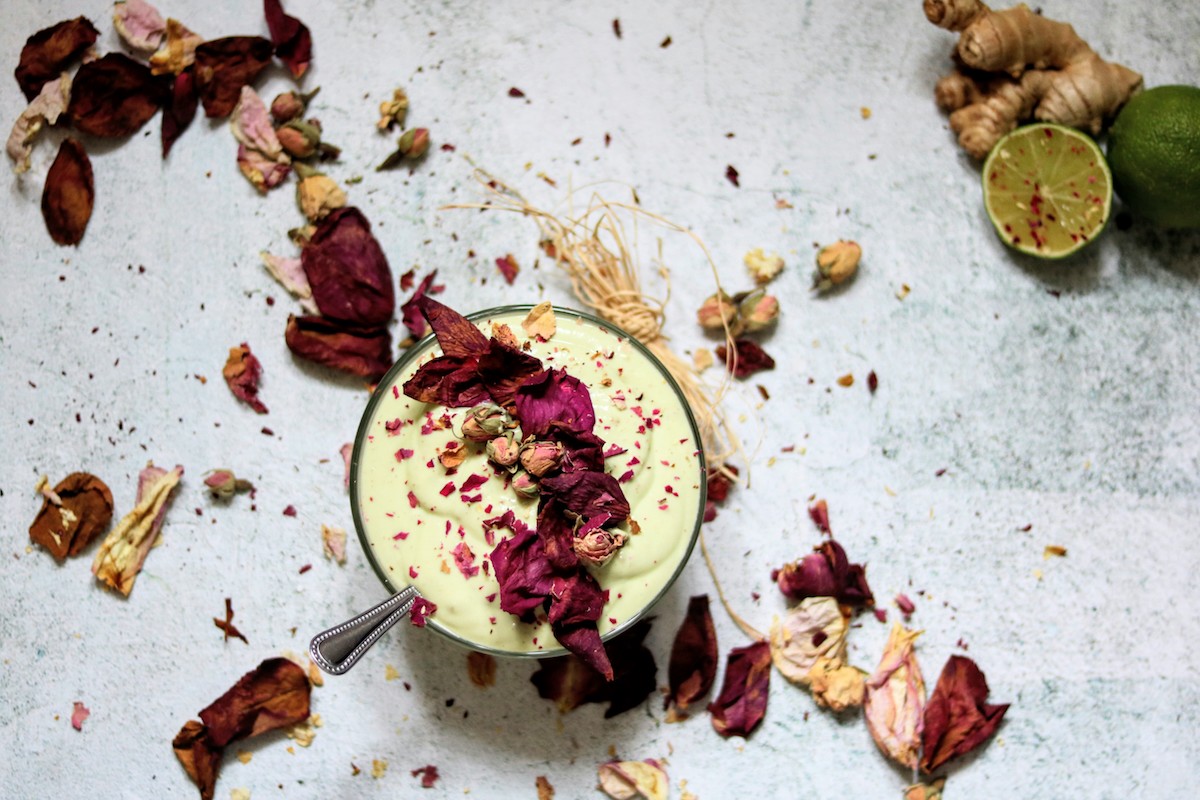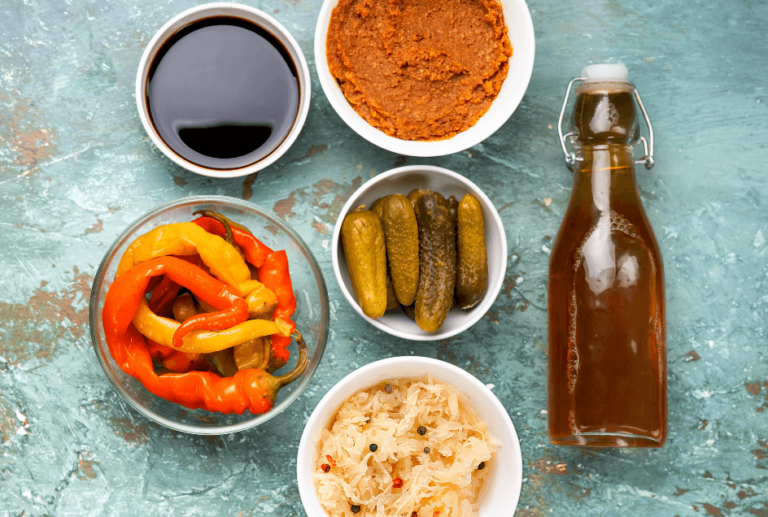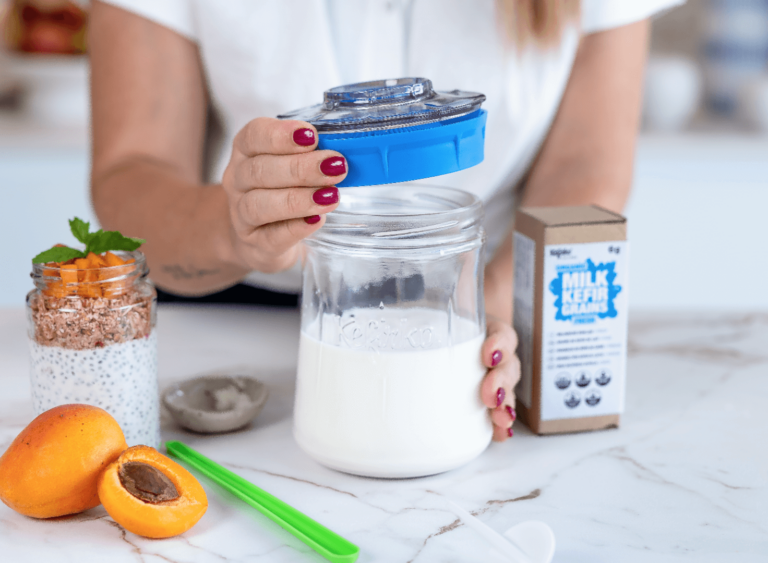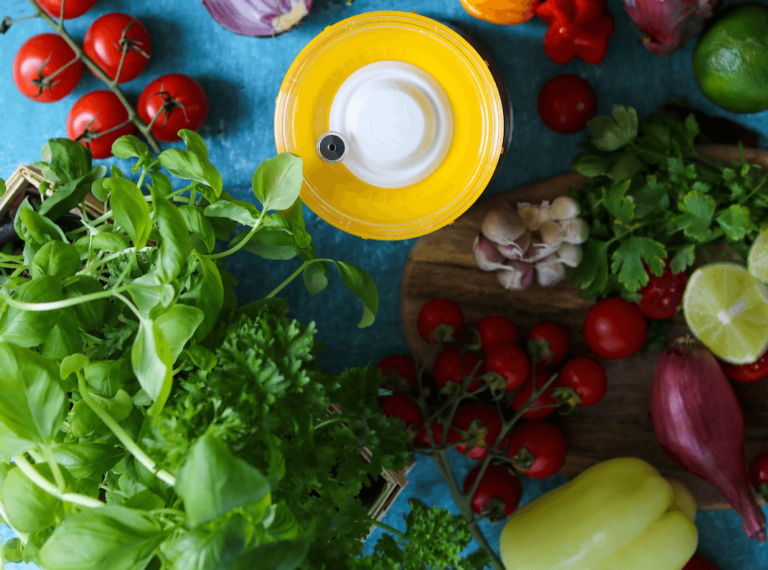Benefits and flavours of the second fermentation

Second fermentation is a great way to boost your homemade kefir with nutrients and flavours.
But first, a little reminder how to second ferment your homemade kefir: after straining the kefir grains, pour the milk kefir into a glass jar and leave it covered at room temperature for another 6 – 24 hours.
Choose glass jars with a lid. I do second fermentation in a Kefirko glass jar.

Why second fermentation?
If you like less sour tasting kefir, and still want a properly matured ferment, second fermentation is the perfect solution.
Second fermentation has another great benefit – an increase in nutrients and probiotic bacteria that they cause. While some people make and consume kefir merely for the taste, many people choose to eat it specifically for its superfood-like healthy components.
On a nutritional level, this can happen to kefir if it has undergone second fermentation:
- B Vitamins: Milk kefir contains B vitamins 1 and 12, as well as biotin, a vitamin that helps the body to assimilate the B vitamin family. Second fermentation significantly increases the levels of these vitamins in kefir.
- Calcium & Magnesium: Milk kefir contains up to 20% of the RDA for calcium, and 5% of the RDA for magnesium. Second fermentation increases the bioavailability of both of these vitamins.
- Probiotic Bacteria: Because fermentation is allowed to carry on for an extra time when doing second fermentation, the levels of probiotic bacteria present in the kefir also rise.
- Reduced lactose: Second fermentations in milk kefir also lower the levels of lactose present in kefir. This is a big plus for those with lactose intolerance or sensitivity.

To flavour or not?
Not only does a second fermentation lessen the sourness, reduce lactose levels and increase nutritional levels, but it also provides an opportunity to add ingredients and experiment with flavouring.
This not recommended for the primary fermentation process because foreign substances can contaminate your kefir grains and have a harmful effect on them. Additional ingredients in the primary fermentation can also sometimes interfere with the fermentation process itself.
However, the kefir grains are not present during a second fermentation. This means that you can add any prebiotic food you like without it affecting your kefir culture in any way. It’s important to select food rich in prebiotics for the second fermentation. Kefir is rich in probiotics and prebiotics act as food for probiotics. In other words, probiotics eat prebiotics!

Some suggestions to get you inspired:
Sweet Kefir Flavours
Fruit– apple, citrus (you can use pieces of fruit or thin slices of peel), pineapple, cherries, strawberries, banana, passion fruit, guava, papaya, raspberries, blueberries, grapes, blackberries, mango…
Spices– cinnamon (sticks can be removed, powdered form can be left in when bottled for refrigeration), nutmeg, cloves (in very small quantities as it can be too intense, pairs well with apple)
Sweeteners– honey, blackstrap molasses (use sparingly, as taste can be very strong), dates or date paste, maple syrup, agave syrup (unprocessed gives nice caramel flavour)
Savoury Kefir Flavours
Veggies & Herbs– onion, garlic, chives, endives, basil, rosemary, thyme, parsley
Tea Flavoured Kefir
To flavour a secondary ferment with tea, use tea bags, or place loose tea in the centre of a piece of cloth and tie with string. Do not use metal tea infusers.
Herbal Teas
Mint, apple mint, lemon balm, honey bush (for a very slight sweet taste), green tea (more commonly used for its antioxidant content than for flavour), lavender, lemongrass, rooibos, chamomile, jasmine tea.
I used berries, orange and spices (cinnamon, anise, cloves) for my homemade kefir second fermentation. What prebiotics will you choose?
This blog post prepared Vedrana Orlović, kefir enthusiast and blogger – Kefirolicious.com.
All you need for second fermentation:
Sources:
- http://theculturedfoodie.com/flavouring-your-milk-kefir-with-a-2nd-fermentation/
- https://www.culturedfoodlife.com/the-trilogy/kefir/how-to-second-ferment-kefir/
- https://www.rebootedmom.com/how-to-second-ferment-kefir/
- https://www.culturesforhealth.com/learn/milk-kefir/second-fermentation-milk-kefir/
- http://phickle.com/getting-started-and-faq/milk-kefir/
- http://kombuchahome.com/second-ferment-kefir/







Have been experimenting with milk kefir. think I finally have a product worthy of drinking. I would like to flavour my Kefir however most recipes I have seen are recommending Jams.
My favorite commercial kefir is the coconut flavour. Any tips on how I would achieve this on a second ferment?
Hi Karen,
thanks for contacting. I would suggest adding coconut milk or mousse to the second ferment. Maybe someone here will have better idea. 😉
Muito obrigado, adorei suas receitas
I have been experimenting with second-fermenting my kefir (been making kefir for years). Would like to add manuka honey AND pineapple together for the second ferment. Question: Is it OK to use these two together, or should I second ferment with only one item?
Hi Mary, thanks for leaving the comment. We’re not sure if they work well, probably that would be ok. Maybe someone else will give you a first-hand experience.
Regards from Kefirko team
Hi, I love your site!
I am considering second fermenting my kefir with beet powder. Do you think that would work?
Hi Mary,
that may give you an interesting result. Try it out! 😉
Isn’t honey antibacterial?? Adding honey for second fermentation could cause the healthy prebiotic bacterias to die….
jun kombucha is quite common in kombucha making and it’s made with honey instead of sugar. See more: https://uk.kefirko.com/blog/how-to/brew-kombucha-tea-at-home/